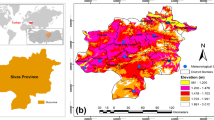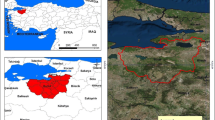Abstract
The aim of this study is to investigate the relationship between bioclimatic comfort and land use in Trabzon by using geographical information systems and remote sensing technologies. We aimed to evaluate the relationship between the bioclimatic conditions of the years 1985, 1994, 2005, and 2018 with the use of land in the same years in the province of Trabzon in seasonal and annual periods. Physiological equivalent temperature (PET) index, which takes into consideration the physiological characteristics of humans, was used when determining bioclimatic comfort zones. The meteorological parameters used in the calculation of this index are as follows: daily average temperature values reduced to sea level, daily average relative humidity, and wind speed. The inverse distance weighting (IDW) method was preferred in the calculation of the spatial distribution of the obtained values at sea level. Using DEM data, height-dependent PET values were obtained and bioclimatic comfort maps were generated. According to the years of the bioclimatic comfort maps produced, land use maps were created by using CORINE land cover data. Then, the relationship between bioclimatic comfort zones and land use was examined.








Similar content being viewed by others
References
Altunkasa, M. F. (1990). Determination of climate-balanced urban green space planning principles in Adana and the example of multi-purpose development of a green field. Institutional Faculty of Agriculture, 5(1), 39–54.
Aricak, B. (2015). Using remote sensing data to predict road fill areas and areas affected by fill erosion with planned forest road construction: A case study in Kastamonu Regional Forest Directorate (Turkey). Environmental Monitoring and Assessment, 187(7), 417. https://doi.org/10.1007/s10661-015-4663-7.
Attia, S. G. M., & Herde, A. D. (2009). Bioclimatic architecture: Design strategies in Egypt. Aachen, Germany: Sustainable Energy Technologies, 1(1):1-17.
Aydin S, Simsek M, Cetinkaya G, Ozturk MZ (2019) Erinç Precipitation Events regime characteristics of indices determined by climatic regions of Turkey. 1st Istanbul International Geography Congress Proceedings, 1st Istanbul International geography Congress, Istanbul University Faculty of Letters, 20–22 June 2019, Istanbul, Turkey.
Bozdogan Sert, E., Turkmen, M., & Cetin, M. (2019). Heavy metal accumulation in rosemary leaves and stems exposed to traffic-related pollution near Adana-İskenderun Highway (Hatay, Turkey). Environmental Monitoring and Assessment, 191(9), 553. https://doi.org/10.1007/s10661-019-7714-7.
Cakir, G., Muderrisoglu, H., & Kaya, L. G. (2016). Assessing the effects of long-term recreational activities on landscape changes in Abant Natural Park, Turkey. Journal of Forestry Research, 27(2), 453–461.
Calıskan, O., & Turkoglu, N. (2012). Analysis of Turkey’s bioclimatic conditions. Journal of Geographical Sciences, 10(2), 151–164.
Cetin, M. (2015a). Determining the bioclimatic comfort in Kastamonu city. Environmental Monitoring and Assessment, 187(10), 640. https://doi.org/10.1007/s10661-015-4861-3.
Cetin, M. (2015b). Evaluation of the sustainable tourism potential of a protected area for landscape planning: A case study of the ancient city of Pompeipolis in Kastamonu. International Journal of Sustainable Development & World Ecology, 22(6), 490–495. https://doi.org/10.1080/13504509.2015.1081651.
Cetin, M. (2015c). Using GIS analysis to assess urban green space in terms of accessibility: Case study in Kutahya. International Journal of Sustainable Development & World Ecology, 22(5), 420–424. https://doi.org/10.1080/13504509.2015.1061066.
Cetin, M. (2016a). Determination of bioclimatic comfort areas in landscape planning: A case study of Cide Coastline. Turkish Journal of Agriculture-Food Science and Technology, 4(9), 800–804.
Cetin, M. (2016b). Sustainability of urban coastal area management: A case study on Cide. Journal of Sustainable Forestry, 35(7), 527–541. https://doi.org/10.1080/10549811.2016.1228072.
Cetin, M. (2016c). A change in the amount of CO2 at the center of the examination halls: Case study of Turkey. Studies on Ethno-Medicine., 10(2), 146–155 http://krepublishers.com/02-Journals/S-EM/EM-10-0-000-16-Web/S-EM-10-2-16-Abst-PDF/S-EM-10-2-146-16-444-Cetin-M/S-EM-10-2-146-16-444-Cetin-M-Tx[7].pdf. Accessed 4 Sept 2019.
Cetin, M. (2017). Change in amount of chlorophyll in some interior ornamental plants. Kastamonu University Journal of Engineering and Sciences, 3(1), 11–19 http://dergipark.gov.tr/download/issue-file/5600. Accessed 3 Sept 2019.
Cetin, M. (2019). The effect of urban planning on urban formations determining bioclimatic comfort area’s effect using satellitia imagines on air quality: A case study of Bursa city. Air Quality, Atmosphere & Health. (Air Qual Atmos Health), 12(10), 1237–1249. https://doi.org/10.1007/s11869-019-00742-4.
Cetin, M., & Sevik, H. (2016). Evaluating the recreation potential of Ilgaz Mountain National Park in Turkey. Environmental Monitoring and Assessment, 188(1), 52. https://doi.org/10.1007/s10661-015-5064-7.
Cetin M, Zeren I (2016) Evaluation of the value of biocomfort for Kastamonu-Inebolu”. International Conference GREDIT’2016 – Green Development Infrastructure Technology, Poster section 4: Management of Urban and Industrial Waste, Climate Change – Biodiversity – Efficiency, ISBN 978-608-4624-21-9, 31.03 and 01.04 2016, p4–35, page: 310, Skopje, Macedonia.
Cetin, M., Topay, M., Kaya, L. G., & Yilmaz, B. (2010). Efficiency of bioclimatic comfort in landscape planning process: The case of Kutahya. Suleyman Demirel University. Journal of Faculty of Forestry, A(1), 83–95 Isparta.
Cetin, M., Adiguzel, F., Kaya, O., & Sahap, A. (2018a). Mapping of bioclimatic comfort for potential planning using GIS in Aydin. Environment, Development and Sustainability, 20(1), 361–375. https://doi.org/10.1007/s10668-016-9885-5.
Cetin, M., Zeren, I., Sevik, H., Cakir, C., & Akpinar, H. (2018b). A study on the determination of the natural park’s sustainable tourism potential. Environmental Monitoring and Assessment, 190(3), 167. https://doi.org/10.1007/s10661-018-6534-5.
Cetin, M., Sevik, H., Canturk, U., & Cakir, C. (2018c). Evaluation of the recreational potential of Kutahya Urban Forest. Fresenius Environmental Bulletin, 27(5), 2629–2634.
Cetin, M., Adiguzel, F., Gungor, S., Kaya, E., & Sancar, M. C. (2019). Evaluation of thermal climatic region areas in terms of building density in urban management and planning for Burdur, Turkey. Air Quality Atmosphere & Health (Air Qual Atmos Health), 12(9), 1103–1112. https://doi.org/10.1007/s11869-019-00727-3.
Daneshvar, M. R. M., Bagherzadeh, A., & Tavousi, T. (2013). Assessment of bioclimatic comfort conditions based on Physiologically Equivalent Temperature (PET) using the RayMan model in Iran. Central European Journal of Geosciences, 5(1), 53–60.
Dereli, Z., Yucedag, C., & Pearce, J. C. (2013). Simple and low-cost method of planning for tree growth and lifetime effects on solar photovoltaic systems performance. Solar Energy, 95, 300–307. https://doi.org/10.1016/j.solener.2013.06.019.
Ghanghermeh, A., Roshan, G., & Nasrabadi, T. (2017). Synoptic approach to forecasting and statistical downscaling of climate parameters (case study: Golestan Province). Pollution, 3(3), 487–504 https://jpoll.ut.ac.ir. Accessed 5 Sept 2019.
Guclu, Y. (2010). Investigation of climate comfort conditions in coastal zone of Aegean region in terms of coastal tourism. International Journal of Human Sciences, 7(1), 794–823.
Kantor, N., & Unger, J. (2010). Benefits and opportunities of adopting GIS in thermal comfort studies in resting places: An urban park as an example. Landscape and Urban Planning, 98(2010), 36–46.
Kaya, L. G. (2009). Assessing forests and lands with carbon storage and sequestration amount by trees in the State of Delaware, USA. Scientific Research and Essays, 4(10), 1100–1108.
Kaya, L. G., Kaynakci-Elinc, Z., Yucedag, C., & Cetin, M. (2018). Environmental outdoor plant preferences: A practical approach for choosing outdoor plants in urban or suburban residential areas in Antalya, Turkey. Fresenius Environmental Bulletin., 27(12), 7945–7952.
Kaya, E., Agca, M., Adiguzel, F., & Cetin, M. (2019). Spatial data analysis with R programming for environment. Human and Ecological Risk Assessment: An International Journal, 25(6), 1521–1530. https://doi.org/10.1080/10807039.2018.1470896.
Kocman, A. (1991). Effects of Izmir’s urban development of natural environmental factors and related problems. Geography Research Journal, 3, 101 Izmir (in Turkish).
Matzarakis, A., Rutz, F., & Mayer, H. (2010). Modelling radiation fluxes in simple and complex environments: Basics of the RayMan model. International Journal of Biometeorology, 54, 131–139.
Meteorology (2018) Trabzon city meteorological data. General Directorate of Meteorology.
Milne, M. (2013). Climate consultant 5.4, UCLA. Los Angeles: Energy design tool group.
Molanezhad, M. (2017). Statistical modeling of the association between pervasive precipitation a nomalies in Southern Alburz and global ocean-atmospheric patterns. Pollution, 3(1), 167–174 https://jpoll.ut.ac.ir. Accessed 7 Sept 2019.
Municipality (2018) Trabzon Municipality. Retrieved January 21st, 2018 from http://www.trabzon-bld.gov.tr. Accessed 4 Sept 2019.
Navazi, A., Karbassi, A., Mohammadi, S., Zarandi, S. M., & Monavari, S. M. (2017). Incorporating climate change risk management into mitigation and adaptation strategies in urban areas. IJMS, 46(06): 1183-1192.
Nowak, D. J., Walton, J. T., Dwyer, J. F., Kaya, L. G., & Myeong, S. (2005). The increasing influence of urban environments on US forest management. Journal of Forestry, 103(8), 377–382 https://academic.oup.com/jof/article/103/8/377/4598671. Accessed 3 Sept 2019.
Olgyay, V. (1973). Design with climate: Bioclimatic approach to architectural regionalism (190p). Princeton: Princeton University Press.
Ozturk, M. Z., Cetinkaya, G., & Aydin, S. (2017). Climate types of Turkey according to the Köppen-Geiger climate classification. Journal of Geography, 35, 17–27.
Pawar, A. S., Mukherjee, M., & Shankar, R. (2015). Thermal comfort design zone delineation for India using GIS. Building and Environment, 87, 193–206.
Salehi, E., & Zabardast, L. (2016). Application of driving force-pressure-state-impact-response (DPSIR) framework for integrated environmental assessment of the climate change in city of Tehran. Pollution, 2(1), 83–92 https://jpoll.ut.ac.ir. Accessed 2 Sept 2019.
Sevik, H., Ahmaida, E. A., & Cetin, M. (2017). Chapter 31: Change of the air quality in the urban open and green spaces: Kastamonu sample. In I. Koleva, U. D. Yuksel, & L. Benaabidate (Eds.), Ecology, planning and design (pp. 409–422). St. Kliment Ohridski University Press, ISBN: 978-954-07-4270-0.
Song, Y., & Wu, C. (2018). Examining human heat stress with remote sensing technology. GIScience & Remote Sensing, 55(1), 19–37.
Svensson, M. K., Thorsson, S., & Lindqvist, S. (2003). A geographical information system model for creating bioclimatic maps–examples from a high, mid-latitude city. International Journal of Biometeorology, 47(2), 102–112.
Thom, E. C. (1959). The discomfort index. Weatherwise, 12, 57–60.
Topay, M. (2007) The importance of climate for recreational planning of rural areas: Case study of Muğla Province, Turkey. Developments in Tourism Climatology (Edited by: A. Matzarakis, CR de Freitas and D. Scott), 29-36.
Topay, M. (2013). Mapping of thermal comfort for outdoor recreation planning using GIS: The case of Isparta Province (Turkey). Turkish Journal of Agriculture and Forestry, 37(1), 110–120.
Topay, M., & Parladir, M. O. (2015). Suitability analysis for alternative tourism activities with the help of GIS: A case study of Isparta province. Journal of Agricultural Sciences, 21, 300–309.
Toroglu E, Adiguzel F, Kaya O (2015) Kizildag Plateau Karaisali-Adana. Highland Culture and Transhumance Symposium, 6–7 November 2014. Bilecik Seyh Edebali University Publications (Eds: HarunTuncel), pp. 273–296, Bilecik (in Turkish).
Turkoglu, N., Caliskan, O., Cicek, I., & Yilmaz, E. (2012). The effect of urbanization on bioclimatic conditions in Ankara scale. International Journal of Human Sciences, 9(1), 933–955.
Yucedag, C., & Kaya, L. G. (2016). Effects of air pollutants on plants. Mehmet Akif Ersoy University Journal of the Institute of Science and Technology, 7(1), 67–74.
Yucedag, C., Kaya, L. G., & Cetin, M. (2018). Identifying and assessing environmental awareness of hotel and restaurant employees’ attitudes in the Amasra District of Bartin. Environmental Monitoring and Assessment, 190(2), 60. https://doi.org/10.1007/s10661-017-6456-7.
Acknowledgements
This research is Ilknur ZEREN CETIN’s Master Thesis in Kastamonu University, Institute of Science, Programs of Sustainable Agriculture and Natural Plant Resources conducted one of part of this research. She sincerely thanks to her Advisor’s Assoc. Prof. Dr. Hakan Sevik and Kastamonu University.
Author information
Authors and Affiliations
Corresponding author
Ethics declarations
Informed consent
Informed consent was obtained from all individual participants in the study.
Additional information
Publisher’s note
Springer Nature remains neutral with regard to jurisdictional claims in published maps and institutional affiliations.
Rights and permissions
About this article
Cite this article
Zeren Cetin, I., Sevik, H. Investigation of the relationship between bioclimatic comfort and land use by using GIS and RS techniques in Trabzon. Environ Monit Assess 192, 71 (2020). https://doi.org/10.1007/s10661-019-8029-4
Received:
Accepted:
Published:
DOI: https://doi.org/10.1007/s10661-019-8029-4




